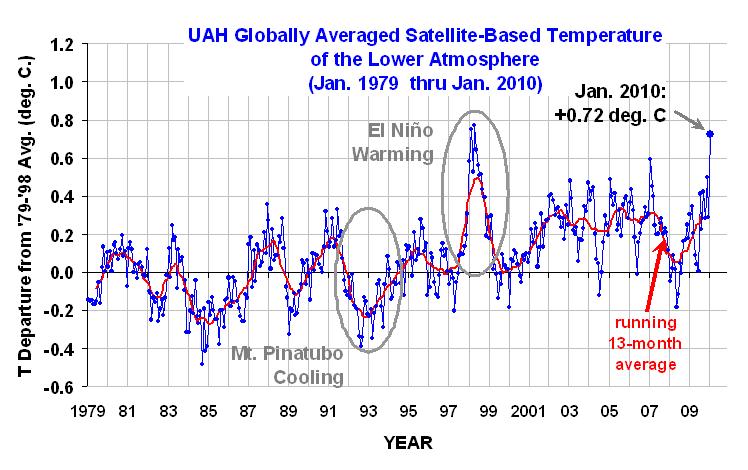Yes, the mid-Atlantic region appears headed toward an epic snow storm as “amazing moisture feeds into what is already a gigantic system,” according to the Capital Weather Gang.
But while the anti-science crowd will no doubt tout that as evidence we aren’t warming — just as they did with the “cold snap” in early January — in fact, climate science predicts we will see more extreme precipitation events year-round as warming puts more moisture into the atmosphere [see Was the “Blizzard of 2009″ a “global warming type” of record snowfall — or an opportunity for the media to blow the extreme weather story (again)?].
Indeed, the January “cold snap” not only didn’t prove the case for (nonexistent) global cooling — it turns out that January was uber-hot around the globe! As leading anti-science guy Roy Spencer posted Thursday (including the figure above):
The global-average lower tropospheric temperature anomaly soared to +0.72 deg. C in January, 2010. This is the warmest January in the 32-year satellite-based data record….
Note the global-average warmth is approaching the warmth reached during the 1997-98 El Nino, which peaked in February of 1998.
Of course, right now we’re only in a moderate El Nino. In 97-98, we had a monster El Nino. And Spencer doesn’t mention that this record is especially impressive because we’re at “the deepest solar minimum in nearly a century.”
The point is, notwithstanding the all-too-effective disinformation campaign of the anti-science crowd, it’s getting hotter — thanks primarily to human emissions.
The satellite record itself clearly shows the long-term warming trend, especially when you remove the stratospheric cooling influences.
You can plot the UAH temperature data yourself:
I’ll blow up relevant part:
Even the supposed record “cold snap” in early January was so localized that the Earth as a whole was relatively quite hot that first week.
While the El Niño has started to weaken, it is still “expected to continue at least into the Northern Hemisphere spring 2010,” according to NOAA. Barring a major volcano, 2010 remains likely to be the hottest year on record.
Related Posts:
- The hottest decade ends and since there’s no Maunder mininum — sorry deniers! — the hottest decade begins
- Must-read AP story: Statisticians reject global cooling; Caldeira — “To talk about global cooling at the end of the hottest decade the planet has experienced in many thousands of years is ridiculous”
- Following third warmest November, December not even close to contiguous U.S. record for cold
- Met Office: “It is not cold everywhere in the world.”
- Breaking: 2009 hottest year on record in Southern Hemisphere and tied for second globally
- Experts: Cold snap doesn’t disprove global warming




